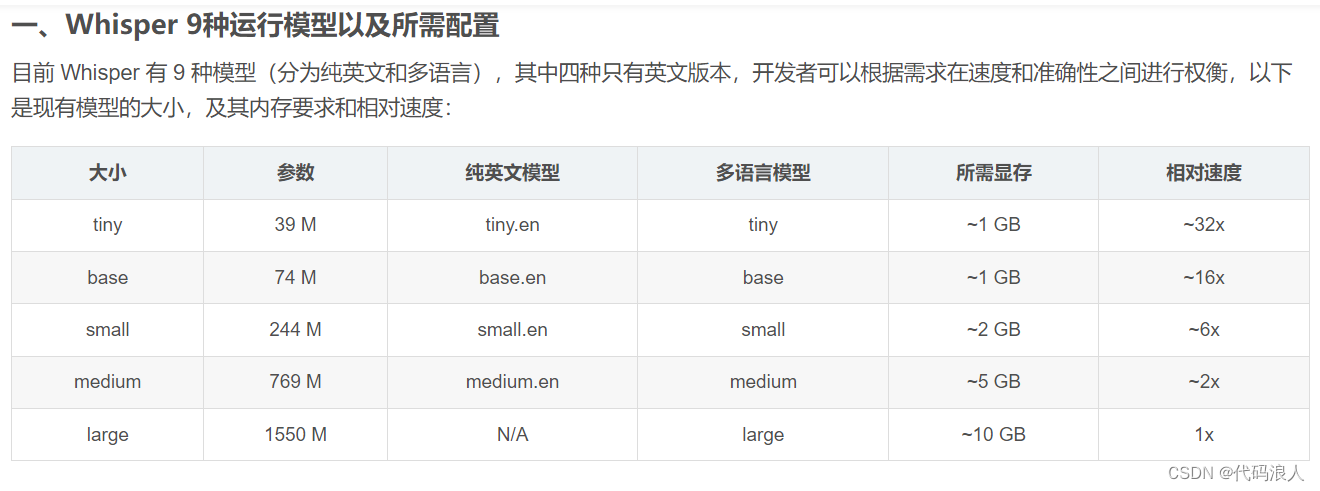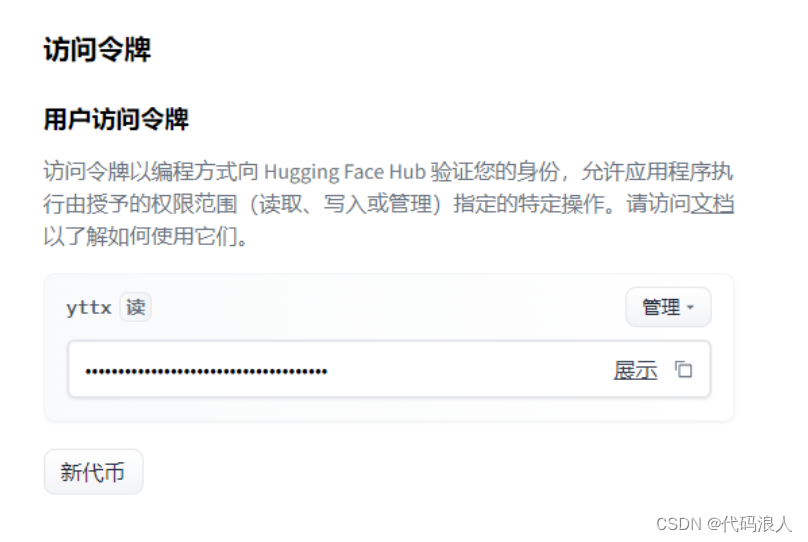本文主要是介绍whisper深入-语者分离,希望对大家解决编程问题提供一定的参考价值,需要的开发者们随着小编来一起学习吧!
文章目录
- 学习目标:如何使用whisper
- 学习内容一:下载、加载模型获得实例
- 1.1 使用whisper.load_model()方法下载,加载
- 1.2 使用实例对文件进行转录
- 1.3 实战
- 学习内容二:语者分离(pyannote.audio)pyannote.audio是huggingface开源音色包
- 第一步:安装依赖
- 第二步:创建key
- 第三步:测试pyannote.audio
学习目标:如何使用whisper
学习内容一:下载、加载模型获得实例

1.1 使用whisper.load_model()方法下载,加载
model=whisper.load_model(参数)
- name 需要加载的模型,如上图
- device:默认有个方法,有显存使用显存,没有使用cpu
- download_root:下载的根目录,默认使用
~/.cache/whisper - in_memory: 是否将模型权重预加载到主机内存中
返回值
model : Whisper
Whisper语音识别模型实例
def load_model(name: str,device: Optional[Union[str, torch.device]] = None,download_root: str = None,in_memory: bool = False,
) -> Whisper:"""Load a Whisper ASR modelParameters----------name : strone of the official model names listed by `whisper.available_models()`, orpath to a model checkpoint containing the model dimensions and the model state_dict.device : Union[str, torch.device]the PyTorch device to put the model intodownload_root: strpath to download the model files; by default, it uses "~/.cache/whisper"in_memory: boolwhether to preload the model weights into host memoryReturns-------model : WhisperThe Whisper ASR model instance"""if device is None:device = "cuda" if torch.cuda.is_available() else "cpu"if download_root is None:default = os.path.join(os.path.expanduser("~"), ".cache")download_root = os.path.join(os.getenv("XDG_CACHE_HOME", default), "whisper")if name in _MODELS:checkpoint_file = _download(_MODELS[name], download_root, in_memory)alignment_heads = _ALIGNMENT_HEADS[name]elif os.path.isfile(name):checkpoint_file = open(name, "rb").read() if in_memory else namealignment_heads = Noneelse:raise RuntimeError(f"Model {name} not found; available models = {available_models()}")with (io.BytesIO(checkpoint_file) if in_memory else open(checkpoint_file, "rb")) as fp:checkpoint = torch.load(fp, map_location=device)del checkpoint_filedims = ModelDimensions(**checkpoint["dims"])model = Whisper(dims)model.load_state_dict(checkpoint["model_state_dict"])if alignment_heads is not None:model.set_alignment_heads(alignment_heads)return model.to(device)
1.2 使用实例对文件进行转录
result = model.transcribe(file_path)
def transcribe(model: "Whisper",audio: Union[str, np.ndarray, torch.Tensor],*,verbose: Optional[bool] = None,temperature: Union[float, Tuple[float, ...]] = (0.0, 0.2, 0.4, 0.6, 0.8, 1.0),compression_ratio_threshold: Optional[float] = 2.4,logprob_threshold: Optional[float] = -1.0,no_speech_threshold: Optional[float] = 0.6,condition_on_previous_text: bool = True,initial_prompt: Optional[str] = None,word_timestamps: bool = False,prepend_punctuations: str = "\"'“¿([{-",append_punctuations: str = "\"'.。,,!!??::”)]}、",**decode_options,
):"""将音频转换为文本。参数:- model: Whisper模型- audio: 音频文件路径、NumPy数组或PyTorch张量- verbose: 是否打印详细信息,默认为None- temperature: 温度参数,默认为(0.0, 0.2, 0.4, 0.6, 0.8, 1.0)- compression_ratio_threshold: 压缩比阈值,默认为2.4- logprob_threshold: 对数概率阈值,默认为-1.0- no_speech_threshold: 无语音信号阈值,默认为0.6- condition_on_previous_text: 是否根据先前的文本进行解码,默认为True- initial_prompt: 初始提示,默认为None- word_timestamps: 是否返回单词时间戳,默认为False- prepend_punctuations: 前缀标点符号,默认为"\"'“¿([{-"- append_punctuations: 后缀标点符号,默认为"\"'.。,,!!??::”)]}、"- **decode_options: 其他解码选项返回:- 转录得到的文本"""
1.3 实战
建议load_model添加参数
- download_root:下载的根目录,默认使用
~/.cache/whisper
transcribe方法添加参数 - word_timestamps=True
import whisper
import arrow# 定义模型、音频地址、录音开始时间
def excute(model_name,file_path,start_time):model = whisper.load_model(model_name)result = model.transcribe(file_path,word_timestamps=True)for segment in result["segments"]:now = arrow.get(start_time)start = now.shift(seconds=segment["start"]).format("YYYY-MM-DD HH:mm:ss")end = now.shift(seconds=segment["end"]).format("YYYY-MM-DD HH:mm:ss")print("【"+start+"->" +end+"】:"+segment["text"])if __name__ == '__main__':excute("large","/root/autodl-tmp/no/test.mp3","2022-10-24 16:23:00")
学习内容二:语者分离(pyannote.audio)pyannote.audio是huggingface开源音色包
第一步:安装依赖
pip install pyannote.audio第二步:创建key
https://huggingface.co/settings/tokens

第三步:测试pyannote.audio
- 创建实例:Pipeline.from_pretrained(参数)
- 使用GPU加速:import torch # 导入torch库
pipeline.to(torch.device(“cuda”)) - 实例转化音频pipeline(“test.wav”)
from_pretrained(参数)
- cache_dir:路径或str,可选模型缓存目录的路径。默认/pyannote"当未设置时。
pipeline(参数)
- file_path:录音文件
- num_speakers:几个说话者,可以不带
from pyannote.audio import Pipeline
pipeline = Pipeline.from_pretrained("pyannote/speaker-diarization@2.1", use_auth_token="申请的key")# send pipeline to GPU (when available)
import torch
device='cuda' if torch.cuda.is_available() else 'cpu'
pipeline.to(torch.device(device))# apply pretrained pipeline
diarization = pipeline("test.wav")
print(diarization)
# print the result
for turn, _, speaker in diarization.itertracks(yield_label=True):print(f"start={turn.start:.1f}s stop={turn.end:.1f}s speaker_{speaker}")
# start=0.2s stop=1.5s speaker_0
# start=1.8s stop=3.9s speaker_1
# start=4.2s stop=5.7s speaker_0
# ...这篇关于whisper深入-语者分离的文章就介绍到这儿,希望我们推荐的文章对编程师们有所帮助!






